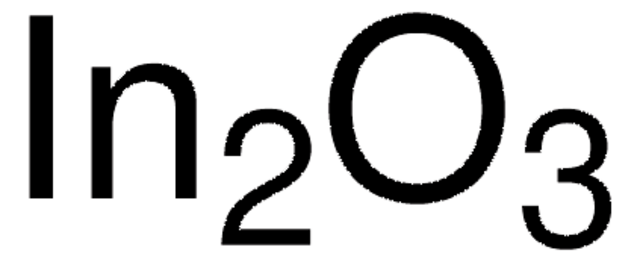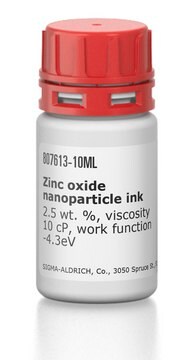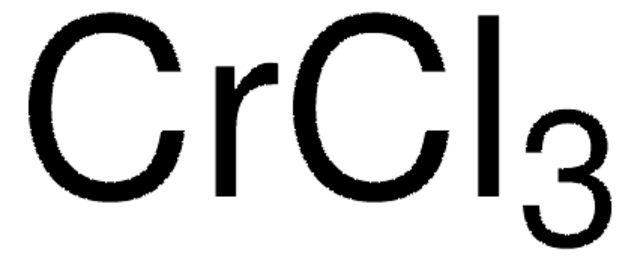632317
Indium(III) oxide
nanopowder, <100 nm particle size (TEM), 99.9% trace metals basis
Sinônimo(s):
Diindium trioxide, Indium sesquioxide
Faça loginpara ver os preços organizacionais e de contrato
About This Item
Fórmula empírica (Notação de Hill):
In2O3
Número CAS:
Peso molecular:
277.63
Número CE:
Número MDL:
Código UNSPSC:
12352302
ID de substância PubChem:
NACRES:
NA.23
Produtos recomendados
pressão de vapor
<0.01 mmHg ( 25 °C)
Nível de qualidade
Ensaio
99.9% trace metals basis
forma
nanopowder
adequação da reação
reagent type: catalyst
core: indium
tamanho de partícula
<100 nm (TEM)
densidade
7.18 g/mL at 25 °C (lit.)
cadeia de caracteres SMILES
O=[In]O[In]=O
InChI
1S/2In.3O
chave InChI
SHTGRZNPWBITMM-UHFFFAOYSA-N
Procurando produtos similares? Visita Guia de comparação de produtos
Descrição geral
Indium(III)oxide is a versatile compound with significant applications in electronics,optics, and materials science. It is widely employed in the synthesis of transparentconducting oxides (TCOs), particularly for flat-panel displays, and solarcells, due to its electrical conductivity and optical transparency. Insemiconductor technology, it is used for making indium tin oxide (ITO),enhancing the performance of electronic devices, and is sensitive to variousgases, making it suitable for gas sensing applications, particularly indetecting hazardous gases.
Aplicação
- Amine Functionalized Surface Frustrated Lewis Pairs for CO2 Photocatalysis: Discusses the enhancement of photocatalytic performance for CO2 reduction using indium oxide hydroxide with amine-functionalized surface frustrated Lewis pairs (Q Guan et al., 2024).
- Enhancing Gas Sensing Performance through UV Photoexcitation: Explores the improvement of room-temperature gas sensing capabilities of metal oxide semiconductor chemiresistors, including indium(III) oxide, by 400 nm UV photoexcitation (S Paul et al., 2024).
- Indium(III) Complexes in Industry and Nanoparticle Synthesis: Reviews the use of trivalent indium complexes as catalysts and precursors for various industrial applications and the synthesis of nanoparticles like indium oxide (TO Ajiboye et al., 2024).
- Ag/In2O3 Inverse Opal Synthesis: Details the synthesis and perspectives of silver/indium oxide inverse opal structures, highlighting their potential in semiconductor applications due to their optical properties (AV Lyutova et al., 2024).
- Photocatalytic Generation of Hydroxyl Radicals and Manganese Species: Investigates the use of indium oxide in enhancing the photocatalytic performance of permanganate for efficient micropollutant removal under visible light (J Li et al., 2024).
Código de classe de armazenamento
11 - Combustible Solids
Classe de risco de água (WGK)
WGK 3
Ponto de fulgor (°F)
Not applicable
Ponto de fulgor (°C)
Not applicable
Equipamento de proteção individual
dust mask type N95 (US), Eyeshields, Gloves
Escolha uma das versões mais recentes:
Já possui este produto?
Encontre a documentação dos produtos que você adquiriu recentemente na biblioteca de documentos.
Os clientes também visualizaram
Xiaoyun Li et al.
Environmental science & technology, 46(10), 5528-5534 (2012-04-12)
Perfluorooctanoic acid (C(7)F(15)COOH, PFOA) has increasingly attracted worldwide concerns due to its global occurrence and resistance to most conventional treatment processes. Though TiO(2)-based photocatalysis is strong enough to decompose most organics, it is not effective for PFOA decomposition. We first
Xuming Zou et al.
ACS nano, 7(1), 804-810 (2012-12-12)
In recent years, In(2)O(3) nanowires (NWs) have been widely explored in many technological areas due to their excellent electrical and optical properties; however, most of these devices are based on In(2)O(3) NW field-effect transistors (FETs) operating in the depletion mode
Dongjin Lee et al.
Sensors (Basel, Switzerland), 11(10), 9300-9312 (2011-12-14)
We report a conductometric nanoparticle biosensor array to address the significant variation of electrical property in nanomaterial biosensors due to the random network nature of nanoparticle thin-film. Indium oxide and silica nanoparticles (SNP) are assembled selectively on the multi-site channel
K H L Zhang et al.
Journal of physics. Condensed matter : an Institute of Physics journal, 23(33), 334211-334211 (2011-08-05)
Epitaxial films of In(2)O(3) have been grown on Y-stabilised ZrO(2)(111) substrates by molecular beam epitaxy over a range of thicknesses between 35 and 420 nm. The thinnest films are strained, but display a 'cross-hatch' morphology associated with a network of
Mareike V Hohmann et al.
Journal of physics. Condensed matter : an Institute of Physics journal, 23(33), 334203-334203 (2011-08-05)
The ionization potentials of In(2)O(3) films grown epitaxially by magnetron sputtering on Y-stabilized ZrO(2) substrates with (100) and (111) surface orientation are determined using photoelectron spectroscopy. Epitaxial growth is verified using x-ray diffraction. The observed ionization potentials, which directly affect
Nossa equipe de cientistas tem experiência em todas as áreas de pesquisa, incluindo Life Sciences, ciência de materiais, síntese química, cromatografia, química analítica e muitas outras.
Entre em contato com a assistência técnica











